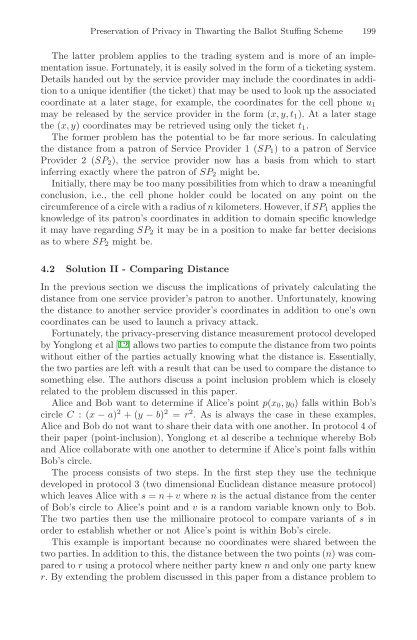Lecture Notes in Computer Science 5185
Lecture Notes in Computer Science 5185
Lecture Notes in Computer Science 5185
You also want an ePaper? Increase the reach of your titles
YUMPU automatically turns print PDFs into web optimized ePapers that Google loves.
Preservation of Privacy <strong>in</strong> Thwart<strong>in</strong>g the Ballot Stuff<strong>in</strong>g Scheme 199<br />
The latter problem applies to the trad<strong>in</strong>g system and is more of an implementation<br />
issue. Fortunately, it is easily solved <strong>in</strong> the form of a ticket<strong>in</strong>g system.<br />
Details handed out by the service provider may <strong>in</strong>clude the coord<strong>in</strong>ates <strong>in</strong> addition<br />
to a unique identifier (the ticket) that may be used to look up the associated<br />
coord<strong>in</strong>ate at a later stage, for example, the coord<strong>in</strong>ates for the cell phone u1<br />
may be released by the service provider <strong>in</strong> the form (x, y, t1). At a later stage<br />
the (x, y) coord<strong>in</strong>ates may be retrieved us<strong>in</strong>g only the ticket t1.<br />
The former problem has the potential to be far more serious. In calculat<strong>in</strong>g<br />
the distance from a patron of Service Provider 1 (SP1) to a patron of Service<br />
Provider 2 (SP2), the service provider now has a basis from which to start<br />
<strong>in</strong>ferr<strong>in</strong>g exactly where the patron of SP2 might be.<br />
Initially, there may be too many possibilities from which to draw a mean<strong>in</strong>gful<br />
conclusion, i.e., the cell phone holder could be located on any po<strong>in</strong>t on the<br />
circumference of a circle with a radius of n kilometers. However, if SP1 applies the<br />
knowledge of its patron’s coord<strong>in</strong>ates <strong>in</strong> addition to doma<strong>in</strong> specific knowledge<br />
it may have regard<strong>in</strong>g SP2 it may be <strong>in</strong> a position to make far better decisions<br />
as to where SP2 might be.<br />
4.2 Solution II - Compar<strong>in</strong>g Distance<br />
In the previous section we discuss the implications of privately calculat<strong>in</strong>g the<br />
distance from one service provider’s patron to another. Unfortunately, know<strong>in</strong>g<br />
the distance to another service provider’s coord<strong>in</strong>ates <strong>in</strong> addition to one’s own<br />
coord<strong>in</strong>ates can be used to launch a privacy attack.<br />
Fortunately, the privacy-preserv<strong>in</strong>g distance measurement protocol developed<br />
by Yonglong et al [12] allows two parties to compute the distance from two po<strong>in</strong>ts<br />
without either of the parties actually know<strong>in</strong>g what the distance is. Essentially,<br />
the two parties are left with a result that can be used to compare the distance to<br />
someth<strong>in</strong>g else. The authors discuss a po<strong>in</strong>t <strong>in</strong>clusion problem which is closely<br />
related to the problem discussed <strong>in</strong> this paper.<br />
Alice and Bob want to determ<strong>in</strong>e if Alice’s po<strong>in</strong>t p(x0,y0) falls with<strong>in</strong> Bob’s<br />
circle C :(x − a) 2 +(y − b) 2 = r 2 . As is always the case <strong>in</strong> these examples,<br />
Alice and Bob do not want to share their data with one another. In protocol 4 of<br />
their paper (po<strong>in</strong>t-<strong>in</strong>clusion), Yonglong et al describe a technique whereby Bob<br />
and Alice collaborate with one another to determ<strong>in</strong>e if Alice’s po<strong>in</strong>t falls with<strong>in</strong><br />
Bob’s circle.<br />
The process consists of two steps. In the first step they use the technique<br />
developed <strong>in</strong> protocol 3 (two dimensional Euclidean distance measure protocol)<br />
which leaves Alice with s = n + v where n is the actual distance from the center<br />
of Bob’s circle to Alice’s po<strong>in</strong>t and v is a random variable known only to Bob.<br />
The two parties then use the millionaire protocol to compare variants of s <strong>in</strong><br />
order to establish whether or not Alice’s po<strong>in</strong>t is with<strong>in</strong> Bob’s circle.<br />
This example is important because no coord<strong>in</strong>ates were shared between the<br />
two parties. In addition to this, the distance between the two po<strong>in</strong>ts (n)wascompared<br />
to r us<strong>in</strong>g a protocol where neither party knew n and only one party knew<br />
r. By extend<strong>in</strong>g the problem discussed <strong>in</strong> this paper from a distance problem to

















